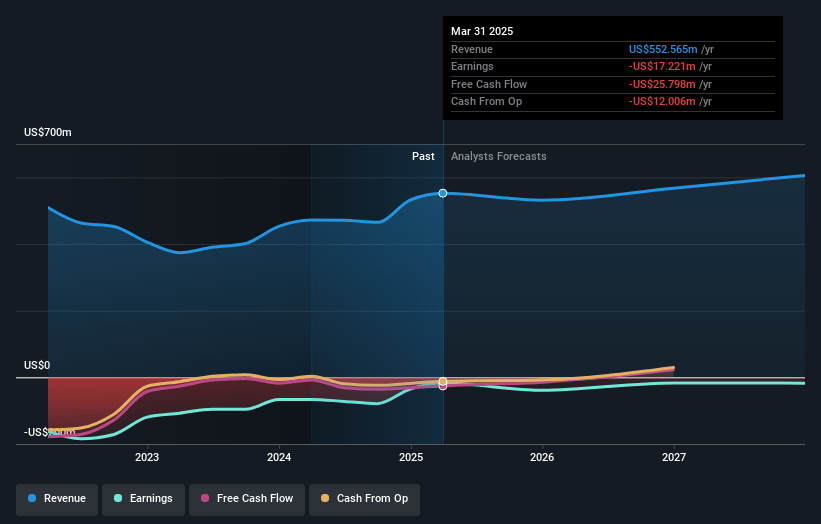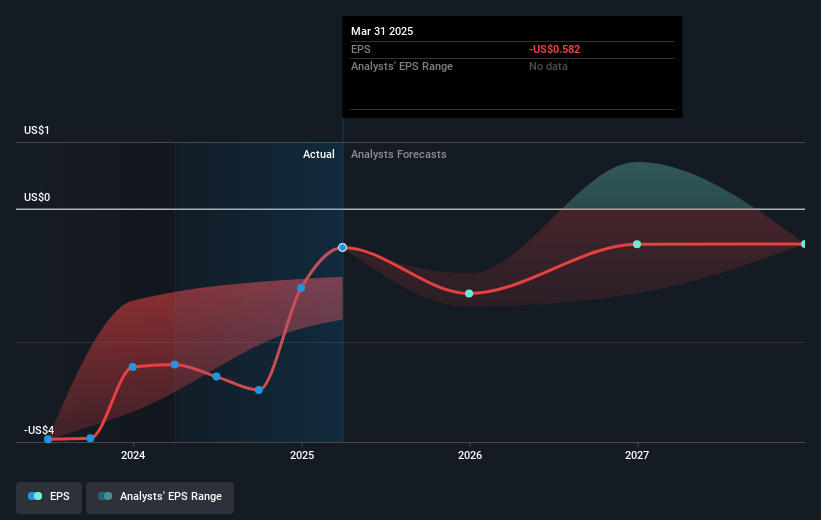Key Takeaways
- Revenue and earnings growth driven by increased Medicare submissions, marketing investments, and enhanced enrollment margins.
- Strategic diversification and AI-driven efficiencies to stabilize earnings, improve margins, and expand operational flexibility.
- Regulatory changes and economic factors could hinder revenue growth, profitability, and operational scaling due to market consolidation, commission suppression, and high upfront investments.
Catalysts
About eHealth- Operates a health insurance marketplace that provides consumer engagement, education, and health insurance enrollment solutions in the United States.
- eHealth experienced a considerable revenue growth of 27% and adjusted EBITDA growth exceeding 70% compared to the previous year, driven mainly by increased Medicare submissions and enhanced enrollment margins, which points to further potential revenue and earnings improvement.
- The company plans to capitalize on the regulatory and market dynamics within the Medicare space, which they believe will drive consumer demand and allow them continued market share growth and scale, impacting future revenue growth.
- eHealth plans to continue investing in marketing and sales operations to capture market share, focusing on increasing brand recognition, audience targeting, and effective messaging, which should contribute to higher revenues and improved net margins due to better customer conversion and retention.
- The expansion of their AI-driven projects is expected to bring about efficiencies across their operations, potentially reducing costs and improving net margins, while also enhancing customer service and lead management capabilities.
- eHealth's strategic priorities, including diversification of revenue streams beyond core Medicare products and strengthening of telesales and carrier relationships, are poised to improve their operational and financial flexibility. This diversification is aimed at stabilizing their earnings and providing a long-term revenue base.
eHealth Future Earnings and Revenue Growth
Assumptions
How have these above catalysts been quantified?- Analysts are assuming eHealth's revenue will grow by 3.7% annually over the next 3 years.
- Analysts are not forecasting that eHealth will become profitable in next 3 years. To represent the Analyst Price Target as a Future PE Valuation we will estimate eHealth's profit margin will increase from -6.6% to the average US Insurance industry of 10.2% in 3 years.
- If eHealth's profit margin were to converge on the industry average, you could expect earnings to reach $60.3 million (and earnings per share of $1.89) by about May 2028, up from $-35.0 million today.
- In order for the above numbers to justify the analysts price target, the company would need to trade at a PE ratio of 6.8x on those 2028 earnings, up from -5.0x today. This future PE is lower than the current PE for the US Insurance industry at 14.1x.
- Analysts expect the number of shares outstanding to grow by 2.81% per year for the next 3 years.
- To value all of this in today's terms, we will use a discount rate of 6.48%, as per the Simply Wall St company report.
eHealth Future Earnings Per Share Growth
Risks
What could happen that would invalidate this narrative?- Regulatory uncertainty and potential unfavorable policy changes could impact the attractiveness of Medicare Advantage plans, affecting both consumer behavior and eHealth's revenue growth projections.
- Changes in commissions or increased commission suppression by carriers could impact eHealth’s earnings and margins, particularly if competitors exit and the field becomes more challenging.
- The evolving competitive landscape with potential exits may reduce competition short-term, but longer-term could lead to a more consolidated market, which might affect eHealth’s growth opportunities and its market share impact on revenue.
- Limited success of the Amplify model, influenced by carriers’ focus on margin protection over growth, could hamper operational scaling and impact both top-line growth and overall profitability.
- Economic pressures or constraints on cash flow due to high upfront cash investments and timing of collections against acquisition costs could negatively affect operating cash flow and capital structure flexibility.
Valuation
How have all the factors above been brought together to estimate a fair value?- The analysts have a consensus price target of $10.625 for eHealth based on their expectations of its future earnings growth, profit margins and other risk factors. However, there is a degree of disagreement amongst analysts, with the most bullish reporting a price target of $12.0, and the most bearish reporting a price target of just $9.5.
- In order for you to agree with the analyst's consensus, you'd need to believe that by 2028, revenues will be $594.2 million, earnings will come to $60.3 million, and it would be trading on a PE ratio of 6.8x, assuming you use a discount rate of 6.5%.
- Given the current share price of $5.86, the analyst price target of $10.62 is 44.8% higher.
- We always encourage you to reach your own conclusions though. So sense check these analyst numbers against your own assumptions and expectations based on your understanding of the business and what you believe is probable.
How well do narratives help inform your perspective?
Disclaimer
AnalystConsensusTarget is a tool utilizing a Large Language Model (LLM) that ingests data on consensus price targets, forecasted revenue and earnings figures, as well as the transcripts of earnings calls to produce qualitative analysis. The narratives produced by AnalystConsensusTarget are general in nature and are based solely on analyst data and publicly-available material published by the respective companies. These scenarios are not indicative of the company's future performance and are exploratory in nature. Simply Wall St has no position in the company(s) mentioned. Simply Wall St may provide the securities issuer or related entities with website advertising services for a fee, on an arm's length basis. These relationships have no impact on the way we conduct our business, the content we host, or how our content is served to users. The price targets and estimates used are consensus data, and do not constitute a recommendation to buy or sell any stock, and they do not take account of your objectives, or your financial situation. Note that AnalystConsensusTarget's analysis may not factor in the latest price-sensitive company announcements or qualitative material.




